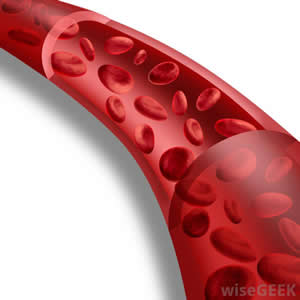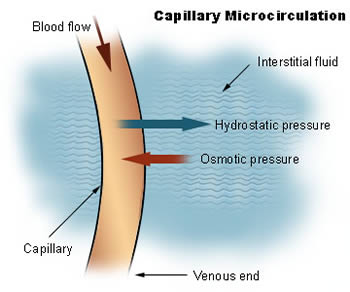Difference between Blood and Tissue Fluid
Key Difference: Blood and Tissue Fluid are two different types of extracellular fluid. Blood is an important fluid in our body. It serves a variety of functions such as carrying oxygen and nutrients to the cells and carrying the wastes produced by the cells and the carbon dioxide back. Tissue fluid is officially known as interstitial fluid. Its main function is to help provide cells with nutrients, as well as help in the removal of waste produced by the cells.

Blood and Tissue Fluid are two different types of extracellular fluid. Extracellular fluid is basically the types of fluids that exist outside of cells. The fluids that exist inside of cells are known as intracellular fluid.
Technically, blood is not an extracellular fluid, but the blood plasma which is the fluid that makes up 55% of blood is. The red blood cells, white blood cells and platelets, basically the cells that are a primary component of blood are all suspended in plasma. In addition to these, the blood plasma, and in extension blood itself, also contains various dissolved proteins, glucose, clotting factors, antibodies, mineral ions, hormones and carbon dioxide.
Blood is an important fluid in our body. It serves a variety of functions such as carrying oxygen and nutrients to the cells and carrying the wastes produced by the cells and the carbon dioxide back. The carrying of oxygen and carbon dioxide is mainly the task of red blood cells. The white blood cells are mainly responsible for fighting off infections and helping the body to heal. The platelets help the blood to clot and stop bleeding. Most of the nutrients that the cells require as well as the antibodies are present and carried by the plasma. Blood also helps in regulating temperature, pH balance, and water balance.
An average human has about 5 liters of blood of which 3 liters are plasma. Plasma is about 90% water. Blood makes up approximately 7% of the total body weight. The blood is created in the bone marrow, which is the inner soft part of the bone.
Tissue fluid is officially known as interstitial fluid. It is a type of extracellular fluid; in fact tissue fluid makes up approximately 16% of the total body weight. An average person has about 10 liters of interstitial (tissue) fluid. That is twice the amount of blood. Tissue fluid or interstitial fluid is a type of fluid that is found in the places surrounding the tissues and cells; hence, the name.
 Tissue fluid plays an important part in the body function. Its main function is to help provide cells with nutrients, as well as help in the removal of waste produced by the cells. The tissue fluid is very similar to the plasma, as they both help provide cells with nutrients and assist the cells in waste removal. In fact, the water, ions, and small solutes are constantly exchanged between plasma and interstitial fluids through the walls of the capillaries.
Tissue fluid plays an important part in the body function. Its main function is to help provide cells with nutrients, as well as help in the removal of waste produced by the cells. The tissue fluid is very similar to the plasma, as they both help provide cells with nutrients and assist the cells in waste removal. In fact, the water, ions, and small solutes are constantly exchanged between plasma and interstitial fluids through the walls of the capillaries.
After the purpose of the tissue fluid is fulfilled, i.e. it has provided the cell with the required nutrients and picked up the wastes that need to be disposed of, it needs to be gotten rid off. It can’t keep hanging around near the cells as it would cause a build up of fluid. Hence, the tissue fluid passes into the surrounding lymph vessels, which move the tissue fluid along and eventually dump it back into the blood. The blood then does its job and disposes of the wastes from the tissue fluid. If the tissue fluid is not removed then its can cause a build up of fluid which can result in swelling, especially around the feet and ankles where gravity pulls the fluid to. This is generally known as an edema.
Comparison between Blood and Tissue Fluid:
|
|
Blood |
Tissue Fluid |
|
Description |
Blood is a reddish fluid that is part of the circulatory system that helps transport oxygen and nutrients to the cells and the removal of waste from those cells. |
Interstitial fluid or Tissue fluid is a type of fluid that is found in spaces around the cells. It helps provide cells with nutrients and assist the cells in waste removal. |
|
Type of |
Extracellular fluid |
Extracellular fluid |
|
Part of |
The circulatory system |
The circulatory system |
|
Made up of |
Red blood cells, white blood cells, blood platelets, and blood plasma, which contains various dissolved proteins, glucose, clotting factors, antibodies, mineral ions, hormones and carbon dioxide. |
A water solvent containing sugars, salts, fatty acids, amino acids, coenzymes, hormones, neurotransmitters, as well as waste products from the cells. |
|
Function |
|
|
Image Courtesy: janekdickinson.com, en.wikipedia.org









Comments
Thanks for this it really very helpful. I do my HW by this
pratibha bouddh
Mon, 04/27/2015 - 23:21
Thanks for this it really very helpful. I do my HW by this
pratibha bouddh
Mon, 04/27/2015 - 23:16
Add new comment